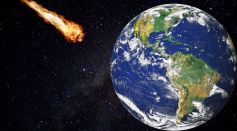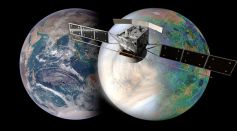Tags: Venus
NASA DAVINCI Mission: Soar Through Venus’ Atmosphere With This Stunning Footage [Watch]

NASA Detects Massive Asteroid Similar to the Size of Dubai’s Burj Khalifa Passing by Earth in Mid-December; Should We Worry?
Up in the Sky: Venus, Jupiter, Saturn Captured in Stunning Photos as They All Line Up with the Moon
Venus in the Sky: How to See Earth’s Evil Twin Before Halloween 2021 Starts!
Unsolved Mysteries of Venus: 4 Secrets You Should Know About Earth's Evil Twin
Venus Too Hot And Dry To Support Life, Planet May Have Always Been A 'Hellhole'

UAE Eyeing Venus in Its Next Interplanetary Mission Before Studying the Asteroid Belt Between Mars and Jupiter

European Space Agency Prepares for a Venus Flyby Through EnVision Probe
Penguin Feces Containing Element Usually Found on Venus Discovered; Scientists Baffled About Phosphine's Origin
How Does a Venus Mission Look Like? Here's How Russia Did It! [WATCH]
Do You Want to See Venus, Spica Dating in The Night Sky This Week? Here's How!
Christmas Comet: C/2021 A1 Leonard Will Fly Near Earth and Cross Paths with Venus; No Meteor Shower Expected
Solar System Geological Features That You Must Know: Which One's the Most Impressive?
Morning Star Greets Earth With Love: When to Spot Venus in 2021
Venus Flyby: ESA's Solar Orbiter Visits Earth's Hottest Neighbor for the Second Time But Fails to Capture Images of the Planet

New Rocky Exoplanet Half the Mass of Venus Discovered in Another System Orbiting Star L 98-59
Double Venus Flyby Offers New Opportunity to Study Earth's Hottest Neighbor At Two Different Locations

Venus Weather Forecast: Winds Run Backwards at Night on Earth's Evil Twin
Life on Venus: Volcanic Activities Might Explain the Presence of Phosphine in the Atmosphere

Why Is Venus So Bright? Here's How Its Proximity to Earth, Highly Reflected Clouds Affects It
Most Popular

Ocean Acidification, Marine pH Change, and CO2 Absorption: How Coral Reef Damage and Shellfish and Plankton Impacts Threaten Marine Life

Dark Matter Explained: What We Know, What We Don't, and How It Shapes Cosmic Structure

Solar Storm Risks: How Geomagnetic Storms Threaten Earth's Power Grids and Satellites

Memory and Learning: How the Brain Stores, Retrieves, and Forgets Information





